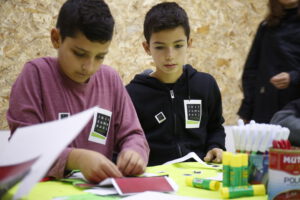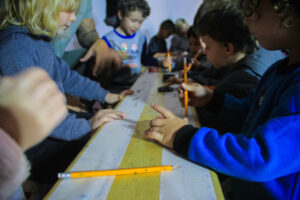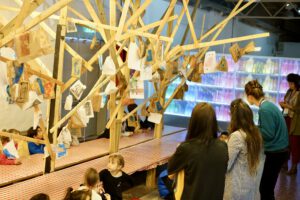Above all else, Zumu sees itself as a socio-educational project that aspires to present art and culture as a shared language that builds bridges and encourages connections. A visit to Zumu is, therefore, suitable for and tailored to all ages. Similarly, the guided tour of the museum, which is based on dialogic teaching, aims to turn visitors into art critics and instill the ability and the right to lead, experience and respond to the art in their own way onto every person who passes through the gate.
We view the museum as a single, unified entity, which weaves Zumu’s design, curation, communal activities, production and communications into an educational initiative whose purpose is not to expose, make accessible or teach art, but rather to share and create, together, a new methodology. We believe that a visit to the museum and the ability to appreciate art is not only possible but also recommended for children and adults alike. Anyone can enjoy art and draw a greater understanding of themselves and the world from it.

In contrast to accepted practices in most of the museums in Israel and the world, in which the youth wing and the education department are not part of the exhibition, children’s exhibits deal solely with subjects related to the “children’s world,” and young visitors are greeted with strict instructions: “stop, be quiet and don’t touch anything,” Zumu’s educational department, which is headed by Halit Michaeli, takes a completely different approach and offers visitors, of all ages a dialogic tour that invites them to touch, feel, and to be part of the discourse. Zumu’s Educational programming begins with a hot cup of tea and cookies, as we believe that a museum should feel like home, and continues with an untethered exploration of the museum whose route depends solely on the subjects and areas of interest that arise in the dialogue between the guides and visitors.
Local Guides—Familiar Faces
Zumu’s educational team always comprises local guides of all ages and backgrounds who speak multiple languages and derive from the various local communities as a deliberate attempt to conquer any fear of museums and turn a visit to a museum into something familiar and almost familial. The local guides serve as ambassadors for Zumu and continue in this spirit even after we have moved on to our next stop. For us, the most exciting thing is to watch the schoolchildren in the afternoon after they have taken part in the morning educational programming, who come back later in the day and guide their families.

We believe that art in general and museums, in particular, are uniquely equipped to help us deal with the abstract and encourage us to ask questions about our identity, essence and environment. This is why the subject of the exhibition is always an integral part of our public programming and why we try to expand the boundaries of socio-cultural discourse. This is also why we invest so much time and thought into how to best prepare the school students for their visit to the museum, through preparatory activities with the educational team and visits with the children by the artists participating in the residency program.
Workshop at the Heart of the Museum
The creative workshop is an integral and indivisible part of a visit to Zumu, and all of the museum tours run through it. In the heart of the museum, it connects the creativity within every visitor to the subject of the exhibition and thus adds another layer to the museum’s creative mix. The workshop, like all of Zumu’s various components, is an intrinsic to every stop and is continually evolving. The creativity it generates enriches the exhibition, adds another dimension to it, and completes the visit to Zumu in every city.
In Yeruham, we reworked the traditional structure of a classroom to unite rather than separate the educator and student while creating a shared identity and future with photographs from Yeruham’s past.

In Arad, we drew inspiration from the towel factory and threaded art tables throughout the space like an uncut film that reached back to the time when the museum space was full of workers.

In Hatzor HaGlilit, we brought creativity down to earth and invited visitors to craft amulets and stones to be included in artistic and religious ceremonies and rituals.

In Kiryat Yam we tried to cultivate something from inside the supermarket and to thread creativity through the aisles and the transience of the exhibition. This gave rise to a tree, which “sprouted” from the museum’s concrete floor on which hundreds of artworks, crafted by school children out of consumable products found in every supermarket, were hung.















